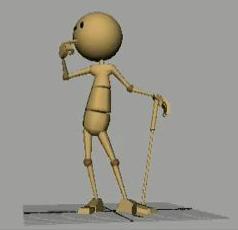Sub-par...
If there's one thing I can say, it's that this school keeps me on my toes. But this week's special. For one thing, I'm passing in the final for the golf swing. That's unfortunate, because last week, Scott gave me some pretty extensive notes, which I couldn't possibly fit in. Not that his demands were unreasonable, no. See, we were moving t0 Massachusetts. WHAT?! You might say. IN THE MIDDLE OF THE SEMESTER?! You might continue.
Unfortunate as the timing may have been for school, it was perfect for most everything else, so we made it happen. Quite a few things fell into place for that to occur, not the least of those considerations was family, our daughter, the selling of our house, my wife's department getting widdled down to practically nothing, and her imminent resignation, but not hidden at the bottom of it, was the fact that I'd have more time to work on school work once the move was finished (about 10 days) and Siggraph will be in...you guessed it, BOSTON this year! Plus at least 10 other pros helped completely out weigh the cons, and we made the trip.
The bad news. My mid-term movie was a disaster. Yep. I tried like heck to get all of those changes in, but alas, in the end, I had to let it go. There was still half a semester to make u p ground, so I wasn't feeling like I was done for, but boy, it was really tough to just let it slip. And Scott was really cool about it. He understood, and we worked out a plan to keep me in the loop for the ten days during the trip, and I even attended the live QnA from Arkadelphia, Arkansas via the internet at the friendly Hampton Inn! Those be good folk.
p ground, so I wasn't feeling like I was done for, but boy, it was really tough to just let it slip. And Scott was really cool about it. He understood, and we worked out a plan to keep me in the loop for the ten days during the trip, and I even attended the live QnA from Arkadelphia, Arkansas via the internet at the friendly Hampton Inn! Those be good folk.
So, here it is in all it's unfinished-ness.
Click on the image, as usual...
Unfortunate as the timing may have been for school, it was perfect for most everything else, so we made it happen. Quite a few things fell into place for that to occur, not the least of those considerations was family, our daughter, the selling of our house, my wife's department getting widdled down to practically nothing, and her imminent resignation, but not hidden at the bottom of it, was the fact that I'd have more time to work on school work once the move was finished (about 10 days) and Siggraph will be in...you guessed it, BOSTON this year! Plus at least 10 other pros helped completely out weigh the cons, and we made the trip.
The bad news. My mid-term movie was a disaster. Yep. I tried like heck to get all of those changes in, but alas, in the end, I had to let it go. There was still half a semester to make u
 p ground, so I wasn't feeling like I was done for, but boy, it was really tough to just let it slip. And Scott was really cool about it. He understood, and we worked out a plan to keep me in the loop for the ten days during the trip, and I even attended the live QnA from Arkadelphia, Arkansas via the internet at the friendly Hampton Inn! Those be good folk.
p ground, so I wasn't feeling like I was done for, but boy, it was really tough to just let it slip. And Scott was really cool about it. He understood, and we worked out a plan to keep me in the loop for the ten days during the trip, and I even attended the live QnA from Arkadelphia, Arkansas via the internet at the friendly Hampton Inn! Those be good folk.So, here it is in all it's unfinished-ness.
Click on the image, as usual...





